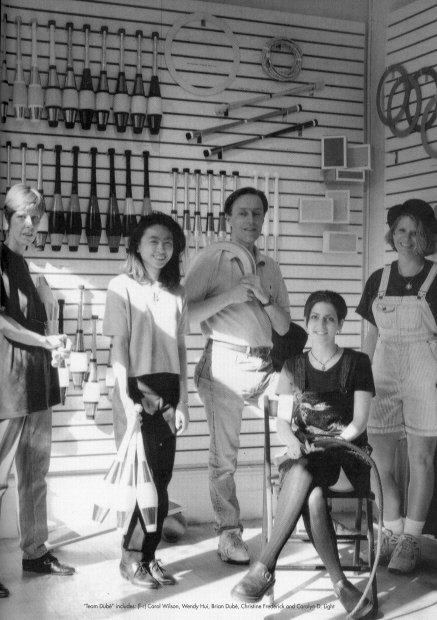
"Team Dube' " includes (l--r) Carol Wilson, Wendy Hui, Brian Dube', Christine Frederick and Carolyn D. Light |
Page 38 Summer 1996
|
Propmaking Pioneer Adjusts to Changes All 'Round by
Scott Malone
One
might not guess it by observing him in action, but impatien...ce has
had a tremendous impact on prop-maker Brian Dube's life. While the
man has shown patience enough to invest tremendous amounts of time
designing props, and last year celebrated the 20th birthday of his
New York-based business, it was a desire to get started immediately
that helped him to find his niche in the juggling world.
Dube'
made his first attempts to juggle in 1975, using plastic balls that
failed to amuse his Siamese cat. Not having a lot of luck with the
featherweight kitty toys, he consulted Carlo's "The Juggling
Book" and stepped up to oranges, because he didn't want to
waste time hunting down the lacrosse balls that the book
recommended.
After
reading the book, Dube' looked up "Juggling Instruction"
in the yellow pages, which led him to Jay Green's engraving business
in Manhattan's jewelry district. Green wowed 24-year-old Dube with
his ability to juggle clubs. He also invited the aspiring juggler to
a juggling workshop then being held in downtown Trinity Church.
Soon,
surrounded by the likes of Michael Moschen, Peter Bell, and Jay
Games, Dube' realized that he wanted to learn clubs. He made his own
set from dowels and bottles, but after using a real set loaned to
him by John Grimaldi, Dube decided that he didn't want to
"waste any time with the make-shift clubs."
Within
three months of his first juggle, Dube' wanted his own set of clubs.
"I placed an order with Jay, and he had a reputation for very
slow delivery. When I told people I had ordered them, they said that
I might be waiting for six months or a year. I didn't want to wait
six months - I barely wanted to wait six hours," Dube said.
At
the time Green and Stu Raynolds were among the only propmakers
around, and since neither had a reputation for prompt delivery, Dube
decided to split the cost of materials for two sets of clubs with
another equipment-starved friend.
With
his only guide the borrowed clubs that he could look at but not
disassemble, Dube' set out to construct some decent props.
"As
I started, I just wanted something that would work, but the more
Soon
Dube's clubs, and his quick turnaround, began to be noticed. Steve
Mills, 18-years-old and already doing five club and seven ball
patterns at Lion's All Star Circus in northern New Jersey, was
frustrated about prop availability when he learned about Dube's
equipment. He looked at some of the clubs, which were made from
green toy bowling pins, and told his friend that while they were
good clubs, they were, "really beat, color-wise. But if you
make them in white, I'll buy them," according to Dube.
The
search for materials began, "We used to drive around to toy
The
color barrier broken, Mills took Dube' under his wing and introduced
him to other local jugglers, including Joe Temple Sr. & Jr.
Mills
word was backed up by Dube's lower prices and better turnaround
times. Dube'
said that prop-making at the time "was in such a primitive
Two
years later, in 1977, Dube' found himself in Delaware at his first
IJA convention, where he got a taste of what it means to be a
celebrity ("like an Albert Einstein, or an actor,"
in his own words). When he arrived on site, he heard that rumors
were circulating that he had arrived at the site with props to sell. |

"Team Dube' " includes (l--r) Carol Wilson, Wendy Hui, Brian Dube', Christine Frederick and Carolyn D. Light |